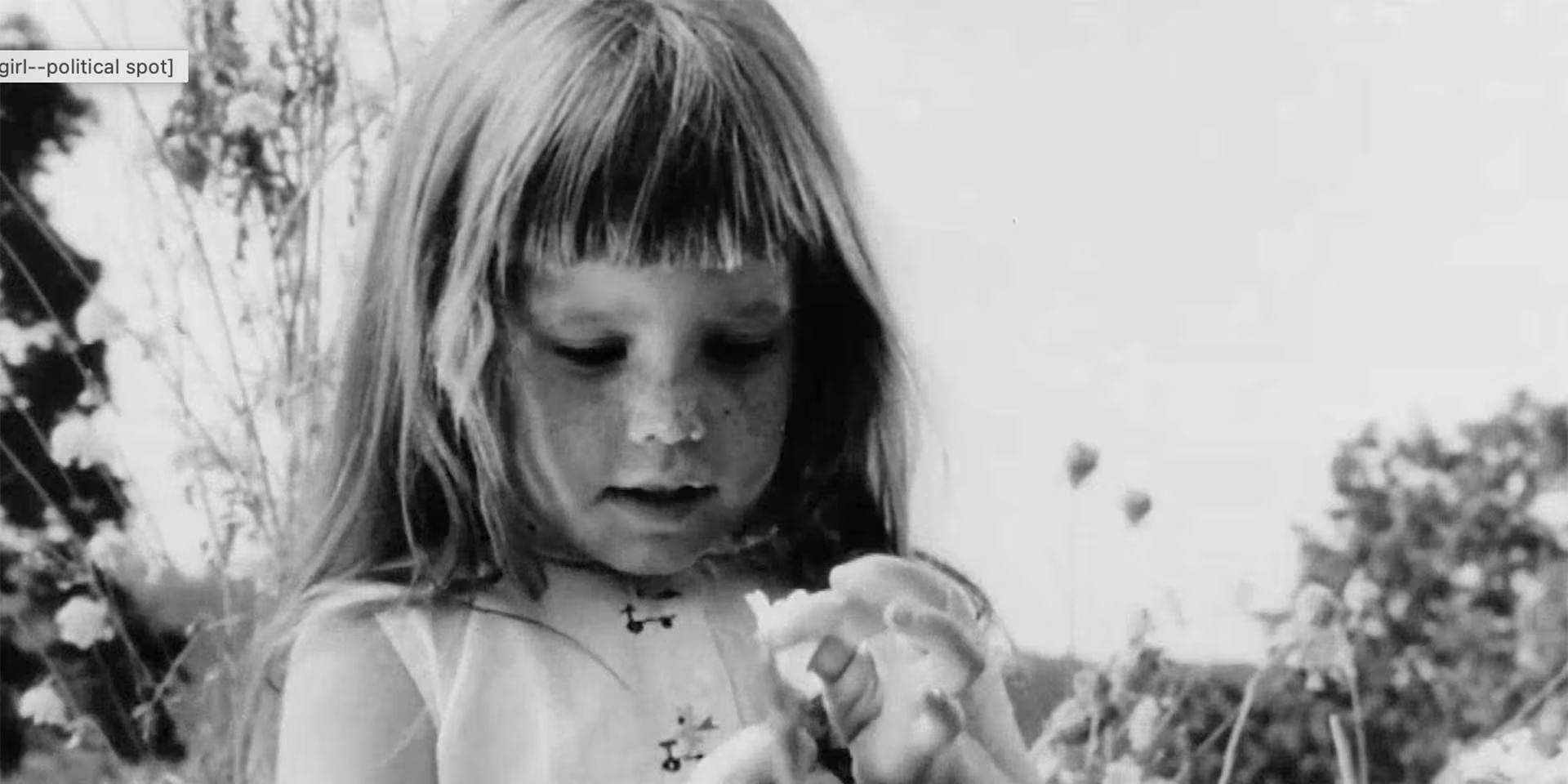In September 1964, a television commercial aired just once. It lasted 60 seconds. It showed a little girl in a sunlit meadow, plucking petals from a daisy as she counted aloud: “One, two, three, four, five, seven, six, six, eight, nine…” Her innocent voice faded into a missile launch countdown. A mushroom cloud erupted on screen. President Lyndon B. Johnson’s voice followed: “These are the stakes. To make a world in which all of God’s children can live, or to go into the dark. We must either love each other, or we must die.”
That ad—known simply as “Daisy”—didn’t just air. It detonated. It became the most talked-about political spot in history, reshaping elections, advertising, and the very way we use video to persuade. But what’s often overlooked is the sheer technological audacity behind its creation. In an era before digital editing, instant playback, or sophisticated sound design, crafting “Daisy” was like building a rocket with a hammer and chisel. As a video production company navigating today’s digital landscape, we find its analog ingenuity both humbling and inspiring. You can explore the full backstory here , but let’s unpack how its creators turned 1960s limitations into revolutionary art.
The Spark That Ignited a Revolution: Triumph Over Technology
Created for Johnson’s campaign against Barry Goldwater, “Daisy” was a masterstroke of emotional storytelling. But achieving its haunting simplicity required overcoming monumental technical hurdles. Imagine editing film with razor blades and tape, synchronizing sound by hand, and creating visual effects without computers. The seamless transition from the girl’s voice to the missile countdown? That wasn’t a digital effect. It was painstakingly crafted using analog tape splicing and multiple audio tracks mixed live—a process requiring surgical precision. The mushroom cloud? Sourced from archival military footage, it was optically printed onto the film, a laborious process involving chemical baths and frame-by-frame alignment. Every dissolve, every sound fade, every visual juxtaposition demanded hours of physical labor in darkrooms and editing suites. There was no “undo” button. A mistake meant starting over. Yet, these constraints forced an unparalleled focus on essentials. The team, led by ad agency Doyle Dane Bernbach and director Tony Schwartz, didn’t just work around the technology; they weaponized its limitations. The raw, slightly grainy texture of the film, the imperfections in the sound mix—these became part of the ad’s unsettling authenticity. In an age of slick digital perfection, “Daisy” reminds us that sometimes, the most powerful stories emerge not from abundance, but from scarcity.
Watch the commercial below:
1964 – Daisy
Why “Daisy” Still Resonates: Craft in the Age of Limitation
At its core, “Daisy” proved that emotion trumps information, but achieving that emotion in 1964 was a feat of analog ballet. Consider the sound design: the child’s voice, recorded separately, had to be perfectly layered over the countdown and Johnson’s narration. Today, we’d manipulate waveforms on a screen; then, it involved physical tape loops, variable-speed playback machines, and mixers that looked like telephone switchboards. The haunting echo effect? Created by feeding the audio through physical chambers and re-recording the ambient reflections. Visually, the contrast between the sunlit, soft-focus meadow and the jarring, high-contrast explosion wasn’t a digital filter. It required careful selection of film stock, precise lighting control during the original shoot, and meticulous optical printing to blend disparate sources into one cohesive, shocking sequence. This wasn’t just editing; it was alchemy. It transformed technical struggle into emotional impact. For modern creators, it’s a profound lesson: constraints breed creativity. When we’re tempted by infinite digital options, “Daisy” challenges us to ask: What’s the essential story? How can we use our tools—however advanced—not to overwhelm, but to focus? The ad’s power lies not in what technology it lacked, but in how its creators used what they had with ruthless intentionality.
The Ripple Effect: From Analog Innovation to Digital Legacy
“Daisy” didn’t just win an election—it changed media forever, proving that video could be a weapon of mass emotional persuasion. Its technical innovations, born of necessity, became foundational. The seamless audio transitions pioneered new paths in sound design. The bold visual juxtapositions redefined montage. The use of archival footage as emotional shorthand became a staple. It birthed the modern “attack ad,” inspiring generations to weaponize emotion and imagery. Crucially, it demonstrated that a single, perfectly crafted piece of video could dominate the cultural conversation far beyond its airtime. Decades later, it’s been parodied, dissected, and studied. Its DNA is in every Super Bowl commercial that makes you cry, every nonprofit video that moves you to donate, and every brand story that feels less like an ad and more like a moment. But its true legacy for creators is this: Great storytelling transcends its tools. The team behind “Daisy” didn’t have 4K cameras or AI-driven editing software. They had vision, courage, and an intimate understanding of how to move people using the raw materials of their time.
What “Daisy” Teaches Us Today: From Analog Grit to Digital Grace
So, why does a 60-year-old ad, forged in the crucible of analog limitation, matter to your video strategy? Because it reminds us that technology serves the story, never the other way around. The creators of “Daisy” weren’t trying to showcase cutting-edge tech; they were trying to stop hearts. They used the cumbersome tools of 1964 not because they were easy, but because they were the only way to achieve their vision. Today, we wield digital alchemy—AI, real-time rendering, infinite layers—that would seem like magic to them. But the core challenge remains the same: cutting through the noise to create something unforgettable. “Daisy” challenges us to wield our powerful tools with the same discipline and purpose its creators brought to their limitations. Can we achieve its emotional clarity without getting lost in digital possibilities? Can we use sound design not just to impress, but to unsettle? Can we craft visuals that linger because of their meaning, not just their resolution? It’s about honoring the craft behind the click.
At WeDoVids, we stand on the shoulders of analog pioneers like the “Daisy” team. We harness the incredible power of modern digital production—4K, HDR, spatial audio, AI-driven insights—but we never lose sight of the fundamental truth they proved: Video’s ultimate power lies in its ability to make us feel. Whether we’re meticulously color grading a brand film or synchronizing complex soundscapes for a documentary, we channel that same spirit: using every tool at our disposal, old or new, to tell stories that resonate, provoke, and endure. The “Daisy” ad was a warning, a work of art, and a revolution in one—achieved with razor blades, tape, and sheer audacity. It showed us that video, at its best, doesn’t just capture moments—it creates them. It doesn’t just reflect the world—it changes it. And that’s a legacy worth carrying forward, whether our tools are analog or digital.
“The role of video/film and television in shaping our understanding of the world and influencing public opinion is undeniable. They have the power to inform, entertain, and educate us on a wide range of topics, from science and technology to politics and social issues.
When we think about the ways in which our cultural artifacts (movies, TV shows, books, etc.) shape our understanding of reality, it becomes clear that these items are not simply passive reflections of society – they are active agents that help shape society itself.”
Brian Shaffer – WeDoVids
Ready to create videos that move the world, harnessing the spirit of “Daisy” with the power of today? Let’s talk.

